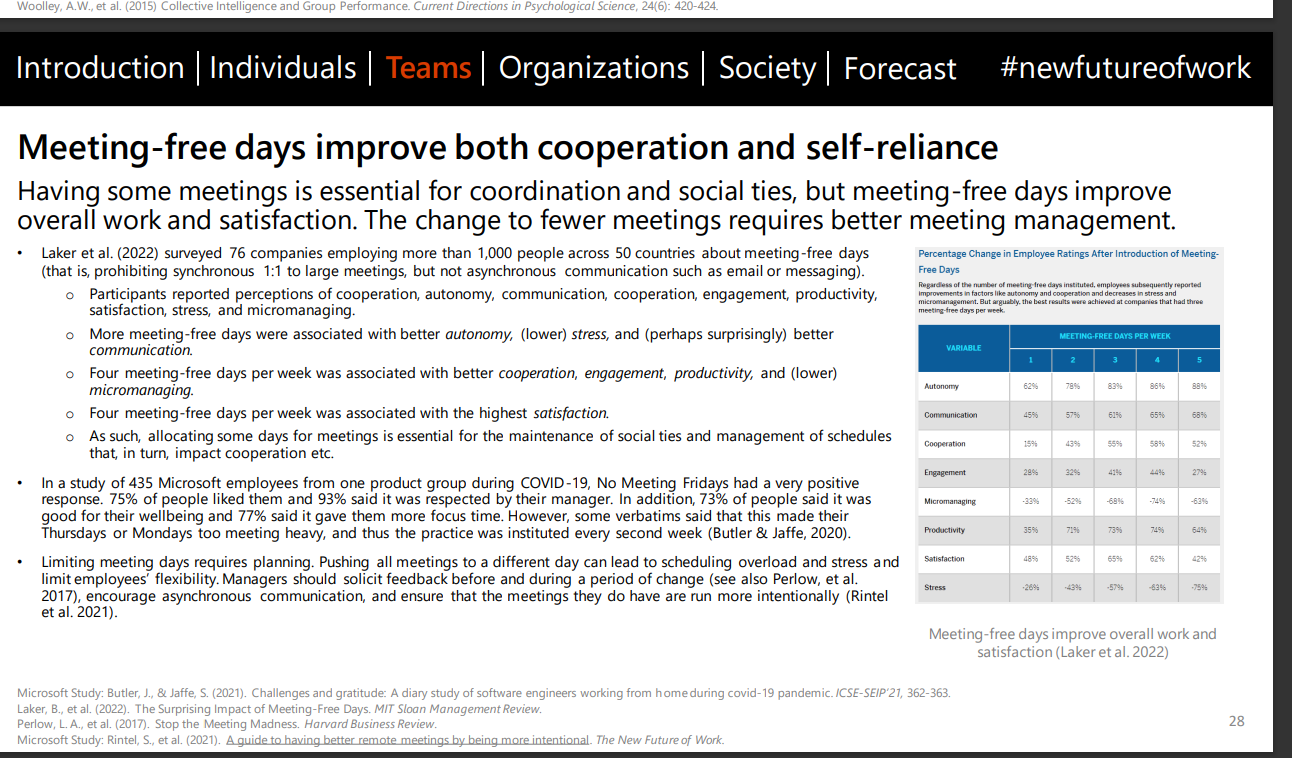For years, we in tech have grumbled about meetings. According to a study from SurveyMonkey, 32% of people think “this meeting could have been an email” all or most of the time. Sometimes we get roped into meetings with a dozen or more people without really knowing why we’re there. And when we get out, we often have just minutes before our next meeting.
At the beginning of the year, Shopify took drastic steps to reduce their meeting burden. They automatically canceled all meetings of three or more people, a total of around 12,000 calendar series and events that would have taken up roughly 322,000 person hours. Chaotic and drastic? Maybe. But as Kaz Nejatian, Shopify’s COO and VP product wrote in the email announcing the change to employees, “We’ve unleashed the ‘chaos monkey’ before and have always come away faster—faster at shipping, at making great decisions, at getting to results and impact. No one joined Shopify to sit in meetings.”
Chances are that no matter where you work, you didn’t join that company for the meetings. You wanted to build software. But the meetings became part of that, and the more senior you are, the more meetings you probably get asked to attend.
In this article, we’re going to take a look at the productivity impact of meetings, reevaluate why we have meetings at all, and consider ways to make meetings better (or avoid them altogether).
One third of meetings are unnecessary
Unless we’re actively multitasking during a meeting (which humans do badly), we’re blocked from other parts of our work: writing code, debugging processes, or designing new features. So if we’re asking for our coworkers’ time, that time should be spent productively. Professor Thomas Fritz of the University of Zurich ran several studies about how software developers perceive their own productivity across their activities. Perceptions across all three studies found that developers view slightly more than half of their meetings negatively. For more from Prof. Fritz, check out our recent podcast with him:
Plenty of things about meetings can make attendees feel they’re wasting their time: guest lists that spiral out of control, overwhelmingly negative participants, and meeting participants who stray off-topic. Otter.ai and Stephen G. Rogelberg, Professor of Organizational Science, Management at UNC Charlotte, found that developers in bad meetings report feeling “frustrated” and “annoyed.” Even good meetings can turn bad if run poorly.
In that same study, they found that developers see about one-third of all meetings as unnecessary—they want to decline 31% of meetings, but only nix 14%. Worse yet, bad meetings not only affect how developers feel about their jobs, they cost organizations money—an estimated $25,000 per employee per year. You can estimate how much any given meeting costs your company with this calculator. And that’s just the direct costs of the meeting, regardless of how disruptive it is to the rest of a developer’s day.
Meetings don’t happen in a vacuum; often they happen back-to-back with other meetings. Microsoft’s Human Factors Lab found that back-to-back meetings cause a great deal of stress and make people worse at meetings.
This wasn’t just a subjective perception. They strapped an EEG cap that measured brain waves to 14 volunteers and either set them up with four consecutive meetings or four meetings with a ten minute meditation break in between. They found that back-to-back meetings caused stress to build up and caused attendees to lose focus and engage worse over time. Surprisingly, one of the biggest sources of stress came from the transition between meetings, as participants tried to switch gears without adequate time.
These factors combine to drag down the company as a whole. In a study of 20 organizations in manufacturing sectors, Simone Kauffeld of Technische Universität Braunschweig and Nale Lehmann-Willenbrock of the University of Amsterdam found that bad meeting behaviors were associated with lower levels of market share, innovation, and employment stability. A company that doesn’t have meeting discipline may soon find their best employees fleeing to greener pastures as their balance sheets slowly drift into the red.
All these downsides to meetings may make you wonder why we have meetings at all.
Wait, why do we have meetings at all?
Obviously, nobody schedules a meeting to torture their coworkers. Meetings are the standard tool for collaboration in companies, ways to find consensus and make a decision, share knowledge, or brainstorm solutions—essentially, they are pop-up communities of practice. Get everyone in a room and talk it out.
The Harvard Business Review quotes an unnamed pharmaceutical executive who sums up the pro-meeting bias that many people in leadership positions hold: “Our abundance of meetings at our company is the cultural tax we pay for the inclusive learning environment that we want to foster…and I’m OK with that. If the alternative to more meetings is more autocratic decision-making, less input from all levels throughout the organization, and fewer opportunities to ensure alignment and communication by personal interaction, then give me more meetings any time!”
In fact, these are all things that I’d wager every one of us wants from a job. We may lionize the enlightened dictator CEOs of the past, but those who attract praise for their decisive style are a perfect example of survivorship bias. Those successful autocratic leaders still need to inspire and motivate their workforce to do the work behind their decisions. If you’ve ever worked for a determined and bull-headed leader who gave orders instead of direction, then you know how painful it is to work in a culture without collaboration.
Many people see reluctance to attend meetings or outright rejection of a meeting as an insult. They hold the attitude of our mystery pharma exec: by rejecting the meeting, you are rejecting an opportunity to collaborate. For one person, maybe that meeting would have been better as an email—you want something done, so send me the requirements/brief so I can do the thing. But another person may see the meeting as a way to feel out an idea, to get a better solution by working with an expert—you.
Those meetings that come during points in the software development lifecycle when collaboration is most important—planning, designing, and setting scope—end up being the ones that feel the least disruptive. At these moments, meetings aren’t taking you away from other work; they are the work. Without all stakeholders coming together and determining what needs to be done, engineering orgs would be coding solutions blind.
Finding ways to have better meetings (or skip them altogether)
But let’s put some big asterisks on “all stakeholders” and “what needs to be done.” The right attendees can make a meeting feel productive for everyone. “I have heard in our studies that there are often meetings that have a lot of participants yet require only a few,” said Professor Fritz. “In my opinion, the most important part of a meeting is to take the time and reflect on who is really necessary for a meeting and even examine whether or not I should participate, and provide an environment in which it is OK to make that decision yourself.” Everyone at the meeting should have a sense of what to do next: Only 56% of participants leave meetings knowing what actions they need to take.
If you need to call a meeting, the research suggests that you need to be a good steward of the meeting, same as you would any other project. More than half of SurveyMonkey participants say two things would make meetings better: a clear agenda and a short meeting time. All participants can improve meetings by being direct, clear, and communicating in a way that leads to a decision. While we all have different communication styles, understanding which ones work best for video calls can make those better, too.
When meetings happen can also make a huge difference in whether people see them as valuable or not. One of the big changes that came with Shopify’s meeting-ageddon was that Wednesdays became meeting-free and Thursday had a block allocated for meetings of 50+ people. In a statement, Nejatian said, “Uninterrupted time is the most precious resource of a craftsperson, and we are giving our people a no judgment zone to subtract, reject meetings, and focus on what is most valuable.”
As the Human Factors Lab research above showed, breaks between meetings are absolutely necessary. But they also found that days without meetings improve overall collaboration, which is the whole reason we have meetings in the first place. And Professor Fritz and his students found that self-reported productivity declined if a developer had more than two meetings in a day.

All this research is a great excuse to have fewer meetings. Meetings will still occasionally be necessary, but limiting them improves developers’ lives. Dropbox uses a framework to identify when something needs a meeting that they call the 3 Ds: decisions, debates, and discussion. These are the business actions that need people to collaborate in order to get them done. Everything else can be served in other ways.
It’s worth thinking about how we can use other tools to take the place of those meetings we call reflexively. Status check-ins like the standup meeting have traditionally been served by actual meetings where everyone reports the status of their projects one at a time. But if companies genuinely want to embrace remote options (and preferably, asynchronous working), there are plenty of tools that will let you do that without turning on your camera. Better yet, there are tools that can automate status updates for you.
Especially for companies with remote options, finding ways to replace the visibility of office life can make a lot of the pushes for video meetings moot. Working in public as much as possible can help share information across teams and give everyone access to the company’s domain experts. Greater transparency reduces the need for meetings, which can build trust and improve overall morale. When we spoke with the folks at 84.51° about how they use Stack Overflow for Teams, Michael Carrico, director of data science, told us, “It's a way to help spread institutional knowledge through that entry point person and make connections. Otherwise it would have been seen as more intrusive to directly ping or email somebody.”
Meetings, especially post-pandemic as more people have gone remote, have become the de facto way we collaborate, and it’s making us all more stressed, less productive, and worse at actually collaborating.
There is hope, but it takes thought, care, and the right tools. We have meetings for genuinely good reasons, but they take a toll on us and our organizations. You don’t have to nuke the calendars from orbit, but finding alternative ways to collaborate will win out in the end. And if you’re interested in improving our overall understanding of meetings, providing the data we need to change company cultures for the better, well Professor Fritz would like to speak to you.
